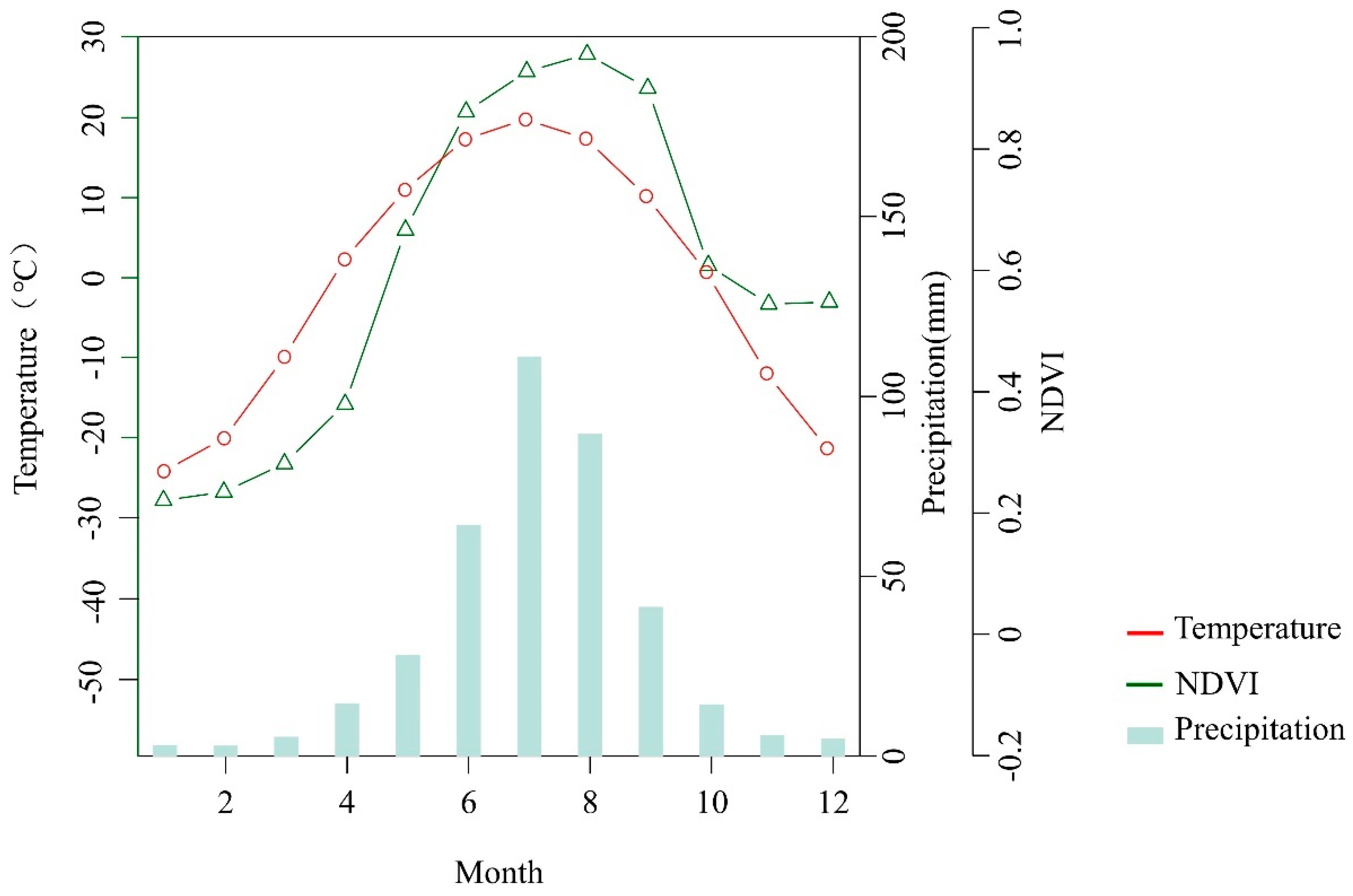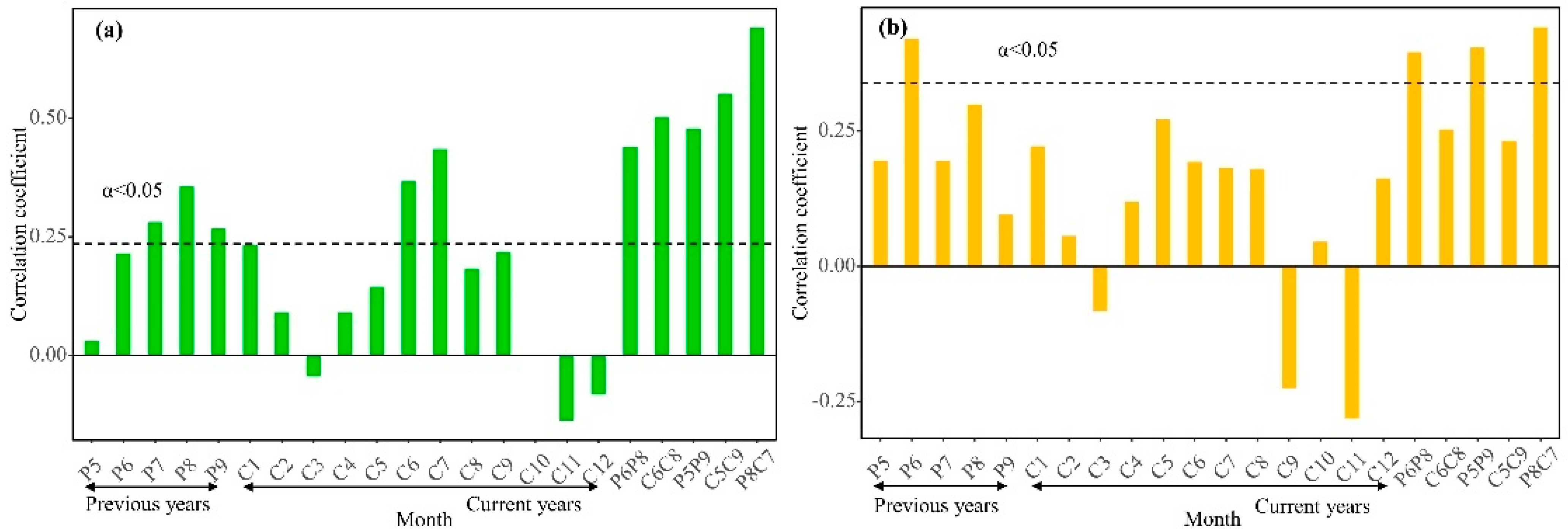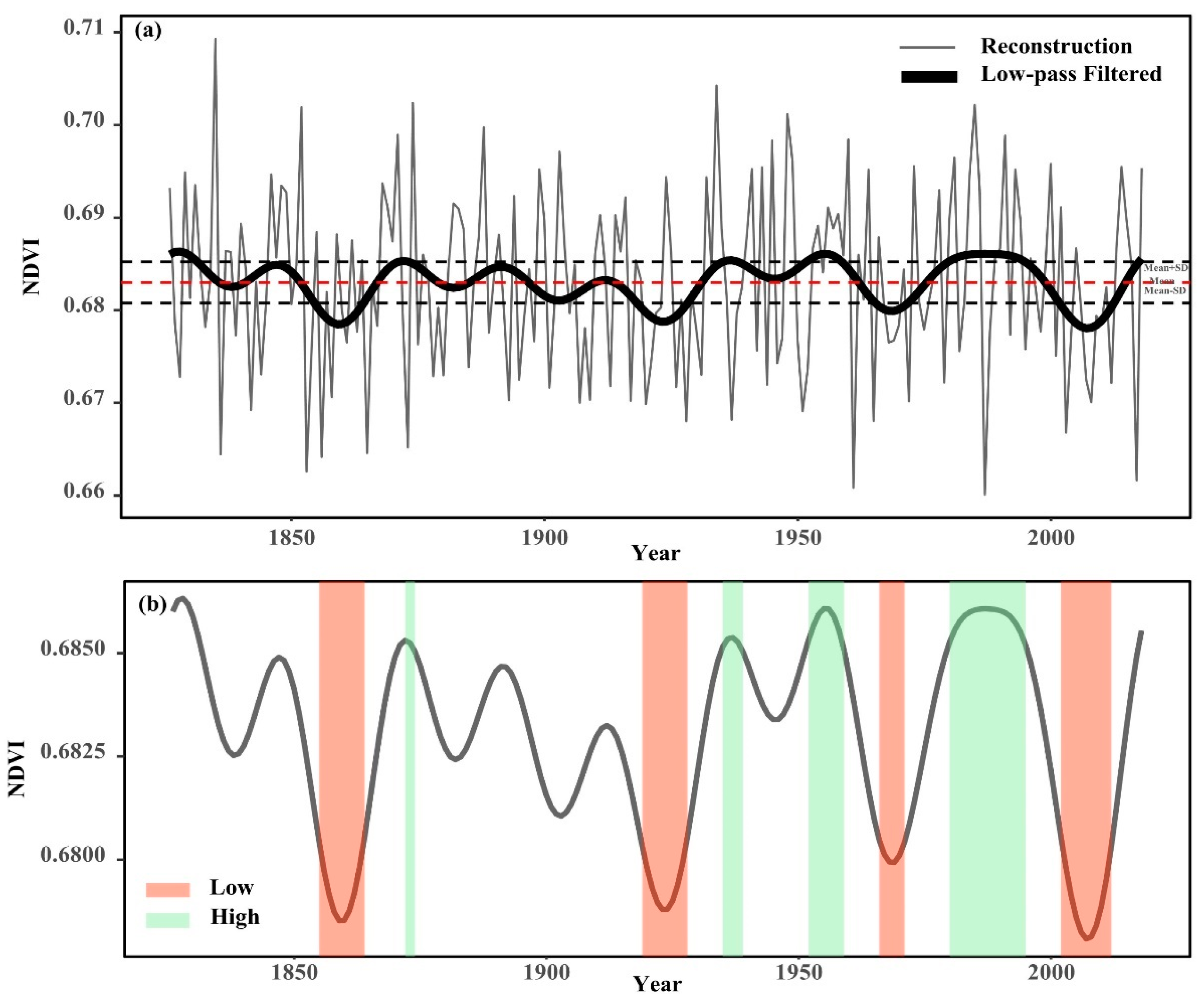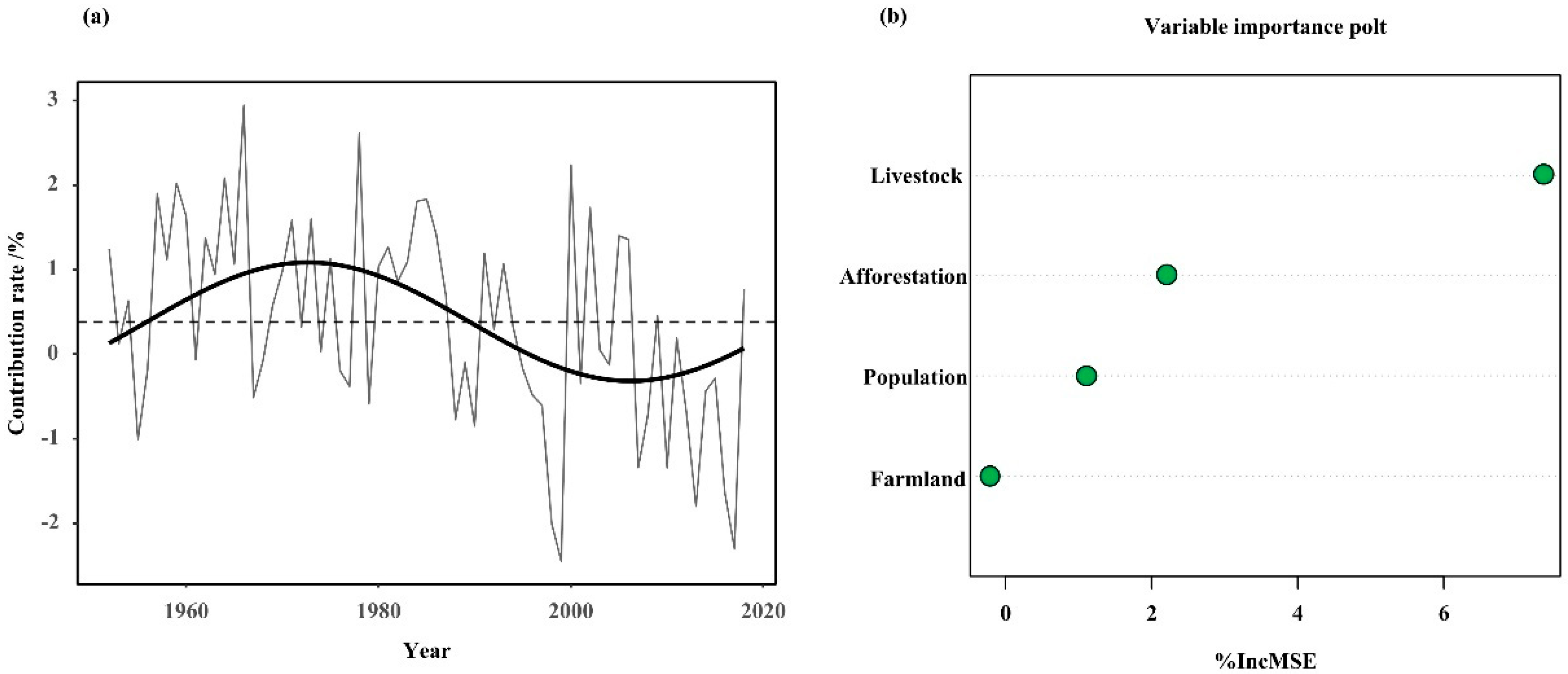Vegetation Greenness Dynamics in the Western Greater Khingan Range of Northeast China Based on Dendrochronology
Abstract
:Simple Summary
Abstract
1. Introduction
2. Materials and Methods
2.1. Study Region
2.2. Dataset
- (1)
- The tree-ring chronology
- (2)
- Climate datasets
- (3)
- NDVI datasets
- (4)
- Socio-economic datasets
2.3. Statistical Analysis
- (1)
- Reconstruction and examination of the NDVI
- (2)
- Extreme events analysis
- (3)
- Analysis of the influencing factors
3. Results and Discussion
3.1. Reconstruction and Examination of the NDVI
3.2. Extreme Events of Vegetation Greenness Dynamics
3.3. The Impact of Climate Change on Vegetation Greenness Dynamics
3.4. The Impact of Human Activities on Vegetation Greenness Dynamics
4. Conclusions
Author Contributions
Funding
Institutional Review Board Statement
Informed Consent Statement
Data Availability Statement
Acknowledgments
Conflicts of Interest
References
- IPCC. Climate Change 2021: The Physical Science Basis; Cambridge University Press: Cambridge, UK, 2021. [Google Scholar]
- Arnell, N.W.; Lowe, J.A.; Challinor, A.J.; Osborn, T.J. Global and regional impacts of climate change at different levels of global temperature increase. J. Clim. Change 2019, 155, 377–391. [Google Scholar] [CrossRef] [Green Version]
- Diedhiou, A.; Bichet, A.; Wartenburger, R.; Wartenburger, R.; Seneviratne, S.I.; Rowell, D.P.; Sylla, M.B.; Diallo, I.; Todzo, S.; Touré, N.D.E.; et al. Changes in climate extremes over West and Central Africa at 1.5 °C and 2 °C global warming. J. Environ. Res. Lett. 2018, 13, 65020. [Google Scholar] [CrossRef]
- Caddy-Retalic, S.; Wardle, G.M.; Leitch, E.J.; McInerney, F.A.; Lowe, A.J. Vegetation change along a Mediterranean to arid zone bioclimatic gradient reveals scale-dependent ecotone patterning. J. Aust. J. Bot. 2020, 68, 574. [Google Scholar] [CrossRef]
- Ukkola, A.M.; De Kauwe, M.G.; Roderick, M.L.; Burrell, A.; Lehmann, P.; Pitman, A.J. Annual precipitation explains variability in dryland vegetation greenness globally but not locally. J. Glob. Change Biol. 2021, 27, 4367–4380. [Google Scholar] [CrossRef]
- Xu, C.; McDowell, N.G.; Fisher, R.A.; Wei, L.; Sevanto, S.; Christoffersen, B.O.; Weng, E.; Middleton, R.S. Increasing impacts of extreme droughts on vegetation productivity under climate change. J. Nat. Clim. Change 2019, 9, 948–953. [Google Scholar] [CrossRef] [Green Version]
- Reichstein, M.; Bahn, M.; Ciais, P.; Frank, D.; Mahecha, M.D.; Seneviratne, S.I.; Zscheischler, J.; Beer, C.; Buchmann, N.; Frank, D.C.; et al. Climate extremes and the carbon cycle. J. Nat. 2013, 500, 287–295. [Google Scholar] [CrossRef]
- Bonan, G.B. Forests and Climate Change: Forcings, Feedbacks, and the Climate Benefits of Forests. J. Sci. 2008, 320, 1444–1449. [Google Scholar] [CrossRef] [Green Version]
- Leão, T.C.C.; Reinhardt, J.R.; Nic Lughadha, E.; Reich, P.B. Projected impacts of climate and land use changes on the habitat of Atlantic Forest plants in Brazil. J. Glob. Ecol. Biogeogr. 2021, 30, 2016–2028. [Google Scholar] [CrossRef]
- Sun, B.; Liu, Y.; Lei, Y. Growing season relative humidity variations and possible impacts on Hulunbuir grassland. J. Sci. Bull. 2016, 61, 728–736. [Google Scholar] [CrossRef] [Green Version]
- Zhang, Z. Tree-rings, a key ecological indicator of environment and climate change. J. Ecol. Indic. 2015, 51, 107–116. [Google Scholar] [CrossRef]
- Liang, E.; Eckstein, D.; Liu, H. Assessing the recent grassland greening trend in a long-term context based on tree-ring analysis: A case study in North China. J. Ecol. Indic. 2009, 9, 1280–1283. [Google Scholar] [CrossRef]
- Srur, A.M.; Villalba, R.; Baldi, G. Variations in Anarthrophyllum rigidum radial growth, NDVI and ecosystem productivity in the Patagonian shrubby steppes. J. Plant Ecol. 2011, 212, 1841–1854. [Google Scholar] [CrossRef]
- Vicente-Serrano, S.M.; Camarero, J.J.; Olano, J.M.; Martín-Hernández, N.; Peña-Gallardo, M.; Tomás-Burguera, M.; Gazol, A.; Azorin-Molina, C.; Bhuyan, U.; El Kenawy, A. Diverse relationships between forest growth and the Normalized Difference Vegetation Index at a global scale. J. Remote Sens. Environ. 2016, 187, 14–29. [Google Scholar] [CrossRef] [Green Version]
- Huang, K.; Zhang, Y.; Zhu, J.; Liu, Y.; Zu, J.; Zhang, J. The influences of climate change and human activities on vegetation dynamics in the Qinghai-Tibet Plateau. J. Remote Sens. 2016, 8, 876. [Google Scholar] [CrossRef] [Green Version]
- Jiang, L.; Bao, A.; Guo, H.; Ndayisaba, F. Vegetation dynamics and responses to climate change and human activities in Central Asia. J. Sci. Total Environ. 2017, 599, 967–980. [Google Scholar] [CrossRef]
- Zheng, K.; Wei, J.; Pei, J.; Cheng, H.; Zhang, X.; Huang, F.; Li, F.; Ye, J. Impacts of climate change and human activities on grassland vegetation variation in the Chinese Loess Plateau. J. Sci. Total Environ. 2019, 660, 236–244. [Google Scholar] [CrossRef]
- Islam AR, M.T.; Islam HM, T.; Shahid, S.; Khatun, M.K.; Ali, M.M.; Rahman, M.S.; Ibrahim, S.M.; Almoajel, A.M. Spatiotemporal nexus between vegetation change and extreme climatic indices and their possible causes of change. J. Environ. Manag. 2021, 289, 112505. [Google Scholar] [CrossRef]
- Park, H.; Jeong, S.; Peñuelas, J. Accelerated rate of vegetation green-up related to warming at northern high latitudes. J. Glob. Change Biol. 2020, 26, 6190–6202. [Google Scholar] [CrossRef]
- King, A.D.; Lane, T.P.; Henley, B.J.; Brown, J.R. Global and regional impacts differ between transient and equilibrium warmer worlds. J. Nat. Clim. Change 2020, 10, 42–47. [Google Scholar] [CrossRef]
- Cook, E.; Kairiukstis, L. Methods of Dendrochronology: Applications in the Environmental Sciences; Springer: Berlin/Heidelberg, Germany, 1990. [Google Scholar]
- Fritts, H. Tree Rings and Climate; Elsevier: Amsterdam, The Netherlands, 2012. [Google Scholar]
- Holmes, R.L. Computer-assisted quality control in tree-ring dating and measurement. J. Tree-Ring Bull. 1983, 43, 51–67. [Google Scholar]
- Cook, E.R. A Time Series Analysis Approach to Tree Ring Standardization (Dendrochronology, Forestry, Dendroclimatology, Autoregressive Process). Ph.D. Thesis, The University of Arizona, Tucson, AZ, USA, 1985. [Google Scholar]
- Hossain, M.L.; Li, J. NDVI-based vegetation dynamics and its resistance and resilience to different intensities of climatic events. J. Glob. Ecol. Conserv. 2021, 30, e1768. [Google Scholar] [CrossRef]
- Lumbierres, M.; Méndez, P.; Bustamante, J.; Soriguer, R.; Santamaría, L. Modeling Biomass Production in Seasonal Wetlands Using MODIS NDVI Land Surface Phenology. J. Remote Sens. 2017, 9, 392. [Google Scholar] [CrossRef] [Green Version]
- Zaimes, G.N.; Gounaridis, D.; Symenonakis, E. Assessing the impact of dams on riparian and deltaic vegetation using remotely-sensed vegetation indices and Random Forests modelling. J. Ecol. Indic. 2019, 103, 630–641. [Google Scholar] [CrossRef]
- Sun, C.; Liu, Y.; Song, H.; Li, Q.; Cai, Q.; Wang, L.; Fang, C.; Liu, R. Tree-ring evidence of the impacts of climate change and agricultural cultivation on vegetation coverage in the upper reaches of the Weihe River, northwest China. J. Sci. Total Environ. 2020, 707, 136160. [Google Scholar] [CrossRef]
- Bao, G.; Liu, Y.; Liu, N.; Linderholm, H.W. Drought variability in eastern Mongolian Plateau and its linkages to the large-scale climate forcing. J. Clim. Dyn. 2015, 44, 717–733. [Google Scholar] [CrossRef]
- Shi, S.; Yu, J.; Wang, F.; Wang, P.; Zhang, Y.; Jin, K. Quantitative contributions of climate change and human activities to vegetation changes over multiple time scales on the Loess Plateau. J. Sci. Total Environ. 2021, 755, 142419. [Google Scholar] [CrossRef]
- Correa-Díaz, A.; Silva LC, R.; Horwath, W.R.; Gómez-Guerrero, A.; Vargas-Hernández, J.; Villanueva-Díaz, J.; Velázquez-Martínez, A.; Suárez-Espinoza, J. Linking Remote Sensing and Dendrochronology to Quantify Climate-Induced Shifts in High-Elevation Forests Over Space and Time. J. Geophys. Res. Biogeosci. 2019, 124, 166–183. [Google Scholar] [CrossRef]
- Wang, Y.; Shen, X.; Jiang, M.; Tong, S.; Lu, S. Spatiotemporal change of aboveground biomass and its response to climate change in marshes of the Tibetan Plateau. J. Int. J. Appl. Earth Obs. Geoinf. 2021, 102, 102385. [Google Scholar] [CrossRef]
- Zhang, Y.; Shi, Z.; Zhu, L.; Wang, C.; Wu, J.; Xu, J. Seasonal variations of non-structural carbohydrate contents in coarse roots of Quercus variabilis Blume at different altitudes in the eastern Qinling Mountain. J. Ecol. 2021, 40, 712–720. [Google Scholar]
- Wang, W.; Liu, X.; Chen, T. Reconstruction of regional NDVI using tree-ring width chronologies in the Qilian Mountains, northwestern China. Chin. J. Plant Ecol. 2010, 34, 1033–1044. [Google Scholar]
- Franco, B.; Tomasz, J.K.; Anna, K.P. Stochastic modeling of regime shifts. J. Clim. Res. 2002, 23, 23–30. [Google Scholar]
- Hegerl, G.C.; Brönnimann, S.; Schurer, A.; Cowan, T. The early 20th century warming: Anomalies, causes, and consequences. J. Wiley Interdiscip. Rev. Clim. Change 2018, 9, e522. [Google Scholar] [CrossRef] [Green Version]
- Liu, Y.; Zhang, X.; Song, H.; Cai, Q.; Li, Q.; Zhao, B.; Liu, H.; Mei, R. Tree-ring-width-based PDSI reconstruction for central Inner Mongolia, China over the past 333 years. J. Clim. Dyn. 2017, 48, 867–879. [Google Scholar] [CrossRef]
- Liu, H.; Park Williams, A.; Allen, C.D.; Guo, D.; Wu, X.; Anenkhonov, O.A.; Liang, E.; Sandanov, D.V.; Yin, Y.; Qi, Z. Rapid warming accelerates tree growth decline in semi-arid forests of Inner Asia. J. Glob. Change Biol. 2013, 19, 2500–2510. [Google Scholar] [CrossRef]
- Han, J.; Chen, J.; Shi, W.; Song, J.; Hui, D.; Ru, J.; Wan, S. Asymmetric responses of resource use efficiency to previous-year precipitation in a semi-arid grassland. J. Funct. Ecol. 2021, 35, 807–814. [Google Scholar] [CrossRef]
- Lin, H.; Chen, Y.; Zhang, H.; Fu, P.; Fan, Z. Stronger cooling effects of transpiration and leaf physical traits of plants from a hot dry habitat than from a hot wet habitat. J. Funct. Ecol. 2017, 31, 2202–2211. [Google Scholar] [CrossRef] [Green Version]
- Wessels, K.J.; Prince, S.D.; Malherbe, J.; Small, J.; Frost, P.E.; VanZyl, D. Can human-induced land degradation be distinguished from the effects of rainfall variability? A case study in South Africa. J. Arid Environ. 2007, 68, 271–297. [Google Scholar] [CrossRef]
- Evans, J.; Geerken, R. Discrimination between climate and human-induced dryland degradation. J. Arid Environ. 2004, 57, 535–554. [Google Scholar] [CrossRef]
- Wang, B.; Xu, G.; Li, P.; Li, Z.; Zhang, Y.; Cheng, Y.; Jia, L.; Zhang, J. Vegetation dynamics and their relationships with climatic factors in the Qinling Mountains of China. J. Ecol. Indic. 2020, 108, 105719. [Google Scholar] [CrossRef]
- Tullo, E.; Finzi, A.; Guarino, M. Review: Environmental impact of livestock farming and Precision Livestock Farming as a mitigation strategy. J. Sci. Total Environ. 2019, 650, 2751–2760. [Google Scholar] [CrossRef]
- Zhang, Q.; Buyantuev, A.; Fang, X.; Han, P.; Li, A.; Li, F.; Liang, C.; Liu, Q.; Ma, Q.; Niu, J.; et al. Ecology and sustainability of the Inner Mongolian Grassland: Looking back and moving forward. J. Landsc. Ecol. 2020, 35, 2413–2432. [Google Scholar] [CrossRef]
- Fan, F.; Liang, C.; Tang, Y.; Harker-Schuch, I.; Porter, R.J. Effects and relationships of grazing intensity on multiple ecosystem services in the Inner Mongolian steppe. J. Sci. Total Environ. 2019, 675, 642–650. [Google Scholar] [CrossRef]
- Li, M.; Li, X.; Liu, S.; Li, X.; Lyu, X.; Dang, D.; Dou, H. Ecosystem services under different grazing intensities in typical grasslands in Inner Mongolia and their relationships. J. Glob. Ecol. Conserv. 2021, 26, e1526. [Google Scholar] [CrossRef]
- Li, A.; Wu, J.; Zhang, X.; Xue, J.; Liu, Z.; Han, X.; Huang, J. China’s new rural “separating three property rights” land reform results in grassland degradation: Evidence from Inner Mongolia. J. Land Use Policy 2018, 71, 170–182. [Google Scholar] [CrossRef]
- Schönbach, P.; Wan, H.; Gierus, M.; Bai, Y.; Müller, K.; Lin, L.; Susenbeth, A.; Taube, F. Grassland responses to grazing: Effects of grazing intensity and management system in an Inner Mongolian steppe ecosystem. J. Plant Soil 2011, 340, 103–115. [Google Scholar] [CrossRef]









| Sampling Sites | Haila’er | Guangtoushan | Huihe Forest |
|---|---|---|---|
| Sample code | HLE | GTS | HHF |
| Elevation (m) a.s.l. | 655 | 770 | 700 |
| Longitude (E) | 119.690238 | 119.980839 | 119.663920 |
| Latitude (N) | 49.194272 | 48.242293 | 48.078830 |
| Sample depth (core/tree) | 72/46 | 33/16 | 54/30 |
| Sampling Sites | Time Span (Year) | Mean Sensitivity (MS) | Series Intercorrelation | Expressed Population Signal (EPS) | Signal-to-Noise Ratio (SNR) | Standard Deviation (SD) | EPS > 0.85 in the First Year (Number of Trees) |
|---|---|---|---|---|---|---|---|
| HLE | 1777–2019, 243 | 0.264 | 0.437 | 0.978 | 44.906 | 0.280 | 1817 (6) |
| GTS | 1828–2019, 192 | 0.178 | 0.715 | 0.890 | 8.065 | 0.273 | 1898 (15) |
| HHF | 1822–2019, 198 | 0.195 | 0.442 | 0.957 | 22.033 | 0.220 | 1886 (10) |
| Calibration | Verification | |||||||
|---|---|---|---|---|---|---|---|---|
| Period | r | R2 | F | Period | RE | CE | ST | ST1 |
| 1982–1998 | 0.51 | 0.26 | 4.55 | 1999–2015 | 0.35 | 0.35 | 12+/5− | 12+/4− |
| 1999–2015 | 0.62 | 0.39 | 6.94 | 1982–1999 | 0.04 | 0.03 | 13+/4− * | 11+/5− |
| 1982–2015 | 0.55 | 0.31 | 6.81 | |||||
| Extreme Events | Period | Duration | Magnitude | Intensity | Extreme Events | Period | Duration | Magnitude | Intensity |
|---|---|---|---|---|---|---|---|---|---|
| Low NDVI values | 1855–1864 | 10 | −0.033 | −0.003 | High NDVI values | 1872–1874 | 3 | 0.006 | 0.002 |
| 1919–1928 | 10 | −0.034 | −0.003 | 1935–1939 | 5 | 0.012 | 0.002 | ||
| 1966–1971 | 6 | −0.016 | −0.003 | 1952–1959 | 8 | 0.022 | 0.003 | ||
| 2002–2012 | 11 | −0.039 | −0.004 | 1980–1995 | 16 | 0.048 | 0.003 |
| r | R2 | p-Value | |
|---|---|---|---|
| 0.68 | 0.47 | 0.42 | <0.01 |
Publisher’s Note: MDPI stays neutral with regard to jurisdictional claims in published maps and institutional affiliations. |
© 2022 by the authors. Licensee MDPI, Basel, Switzerland. This article is an open access article distributed under the terms and conditions of the Creative Commons Attribution (CC BY) license (https://creativecommons.org/licenses/by/4.0/).
Share and Cite
Dong, J.; Yin, T.; Liu, H.; Sun, L.; Qin, S.; Zhang, Y.; Liu, X.; Fan, P.; Wang, H.; Zheng, P.; et al. Vegetation Greenness Dynamics in the Western Greater Khingan Range of Northeast China Based on Dendrochronology. Biology 2022, 11, 679. https://doi.org/10.3390/biology11050679
Dong J, Yin T, Liu H, Sun L, Qin S, Zhang Y, Liu X, Fan P, Wang H, Zheng P, et al. Vegetation Greenness Dynamics in the Western Greater Khingan Range of Northeast China Based on Dendrochronology. Biology. 2022; 11(5):679. https://doi.org/10.3390/biology11050679
Chicago/Turabian StyleDong, Jibin, Tingting Yin, Hongxiang Liu, Lu Sun, Siqi Qin, Yang Zhang, Xiao Liu, Peixian Fan, Hui Wang, Peiming Zheng, and et al. 2022. "Vegetation Greenness Dynamics in the Western Greater Khingan Range of Northeast China Based on Dendrochronology" Biology 11, no. 5: 679. https://doi.org/10.3390/biology11050679
APA StyleDong, J., Yin, T., Liu, H., Sun, L., Qin, S., Zhang, Y., Liu, X., Fan, P., Wang, H., Zheng, P., & Wang, R. (2022). Vegetation Greenness Dynamics in the Western Greater Khingan Range of Northeast China Based on Dendrochronology. Biology, 11(5), 679. https://doi.org/10.3390/biology11050679






